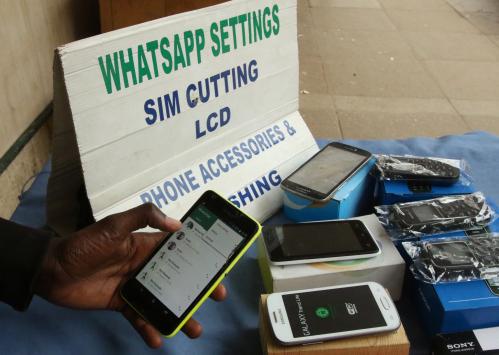When the exodus of Ukrainian refugees began at the end of February, they were received with open arms in neighboring countries, especially in Poland where more than 1 million refugees had arrived by mid-March 2022. Volunteers provided for their basic needs: food, shelter, clothing, and other basic necessities. Often, the most immediate support service was a SIM card, a phone charger, and access to the internet in order to stay connected.
Today, access to the internet is a basic need. The COVID-19 pandemic compounded this need and made the requirement for online access all too clear. Everyone needs a minimum internet package to connect with their loved ones, check and write emails (e.g., to apply for a job), read the news, or fill out forms required for standard administrative procedures.
Expanding the definition of extreme poverty
The concept of “minimum internet needs” builds on the global definition of poverty and links to the World Bank’s World Development Report of 1990, when it created the $1 a day per person definition of extreme poverty as a minimum level of spending needed to meet basic human needs. Since then, the global community has measured extreme poverty in all its forms, leading to ever more sophisticated research on the causes and consequences of poverty, as well as on pathways to end it. One recent highlight of this new poverty research was the awarding of the Nobel Prize in economics in 2019 to Esther Duflo, Abhijit Banerjee, and Michael Kremer for their experimental approach to analyzing poverty. This approach has led to significant improvements in the design of efficient policies to combat economic deprivation.
A new Internet Poverty Index can now adjust the actual cost of internet services in every country to create standardized estimates of people living in internet poverty globally.
This definition of extreme poverty—initially set at $1/day and since 2011, at $1.90/day—encompasses two fundamental elements. First, it quantifies the minimum needs to survive (especially food, shelter, and clothing). Second, it relies on the concept of purchasing power parities (PPPs) so that the costs of these basic needs can be compared across time and space. The current definition is in 2011 PPPs; in today’s U.S. dollar, it is approximately $2.20 (or about 2 euros).
However, people today also need to access a minimum package of internet services as part of basic human needs. To expand on the traditional method of poverty measurement, researchers at World Data Lab have identified and costed a “minimum internet basket,” which combines measures of quantity, quality, and affordability based on consultations with the Alliance for Affordable Internet, Ookla, and GSMA.
Under this expanded definition (see below image), a person is considered internet poor if s/he cannot afford a minimum quantity (1 GB) and quality (10 Mbps download speed) of internet services without spending more than 10 percent of his or her disposable income on these services. This minimum package of internet services would allow a person to fulfill basic needs, such as accessing emails, reading the news, or using government e-services. The core methodology of internet poverty was initially presented in mid-2021 and has undergone additional enhancements to identify the number of internet poor in almost all countries.
 World Data Lab’s just-launched Internet Poverty Index can now adjust the actual cost of internet services in every country to estimate what a standard mobile internet package of 1 GB at 10 MB/second would cost in that country. It then computes how many people in the country could afford such a package. If the cost of the standardized package is above 10 percent of a person’s total spending, the person is considered internet poor. This allows us to create global estimates and share the number of people living in internet poverty globally, with disaggregations available by gender.
World Data Lab’s just-launched Internet Poverty Index can now adjust the actual cost of internet services in every country to estimate what a standard mobile internet package of 1 GB at 10 MB/second would cost in that country. It then computes how many people in the country could afford such a package. If the cost of the standardized package is above 10 percent of a person’s total spending, the person is considered internet poor. This allows us to create global estimates and share the number of people living in internet poverty globally, with disaggregations available by gender.
As with the $1.90 threshold of extreme poverty, the key value added of the approach is not the threshold itself but its consistent measurement across countries and over time. There can be a legitimate discussion about the minimum package, just as there are now suggestions that higher poverty lines be used in lower-middle-income and upper-middle-income countries. For now, however, we use the same package in all countries, which would correspond roughly to $6 per month ($0.19/day; 2011 PPP).
1.4 billion people are living in internet poverty
There are two main findings when we put all the data together. First, there are approximately twice as many people living in internet poverty compared to extreme poverty—this highlights all the work that still needs to be done to close the gap and reduce poverty overall. There are nearly 1.4 billion persons (18 percent of the world population) who live in internet poverty, compared to 675 million living in extreme poverty. Africa is home to 709 million (50 percent) people in internet poverty and Asia to another 457 million (nearly 33 percent). Many Asian countries that have been successful in reducing extreme poverty, such as China, India, Indonesia, and Pakistan, still have a large number of internet poor people.
Figure 1. Brazil, Nigeria, DRC, India, and China account for a third of global internet poverty
 Source: World Data Lab projections.
Source: World Data Lab projections.
Second, while the countries with the highest poverty levels are typically also the places with the highest levels of internet poverty, there are strong differences between countries of similar income levels. For example, among rich countries, the U.S. has about an 85 percent higher cost for the same package of internet compared to Germany. However, there is hardly any internet poverty in Organisation for Economic Co-operation and Development economies, as almost everyone can afford a basic internet package, even if it is expensive. By contrast, among less affluent countries, prices drive internet poverty. In South Africa, a basic internet package costs more than twice that in Kenya and over four times more compared to India. If South Africa had the internet prices of India, internet poverty would decrease by more than 21 million people. When pitted against Kenyan prices, the decline would still be 17 million.
Figure 2. Countries in sub-Saharan Africa have the highest shares of internet poverty
 Source: World Data Lab.
Source: World Data Lab.
While internet poverty remains high at 1.4 billion people, it can be tackled more easily than extreme income poverty. Extreme poverty can be reduced once people achieve higher incomes, which is a gradual and long-term process. Internet poverty, in contrast, can be eradicated much faster if internet prices come down further. Some emerging economies, including India, Kenya, and Colombia, have shown that this is possible.
Note: For the full ranking and additional information on the Internet Poverty Index, see https://internetpoverty.io.
-
Acknowledgements and disclosures
The authors thank Wolfgang Fengler and Isabell Roitner-Fransecky for their inputs and the Internet Society Foundation for supporting this research project.
The Brookings Institution is committed to quality, independence, and impact.
We are supported by a diverse array of funders. In line with our values and policies, each Brookings publication represents the sole views of its author(s).











Commentary
Internet poverty: The next frontier in development
March 31, 2022